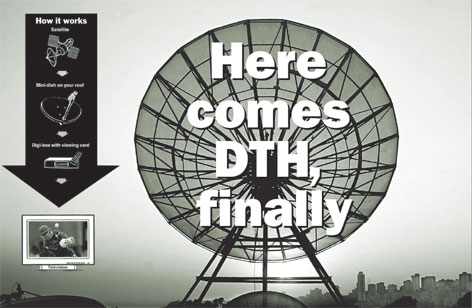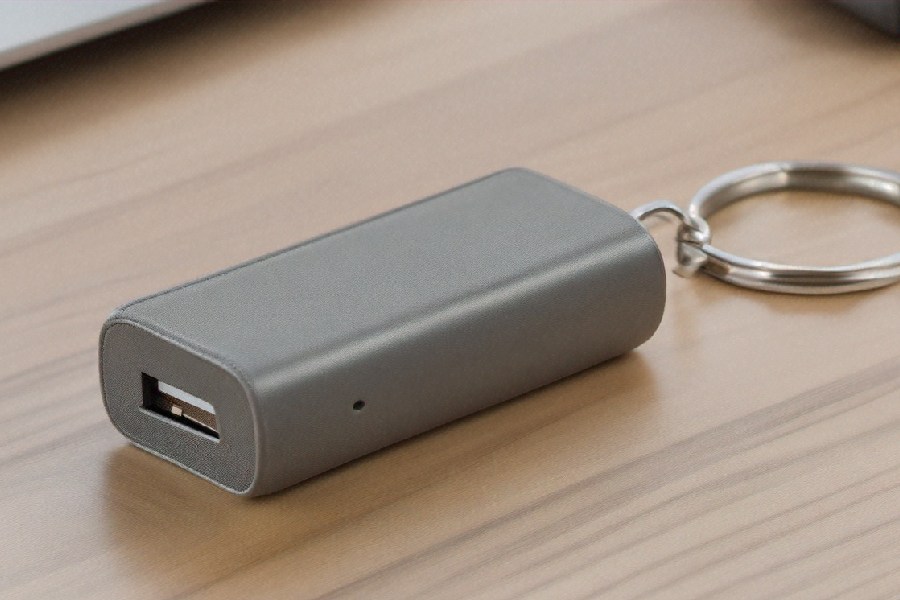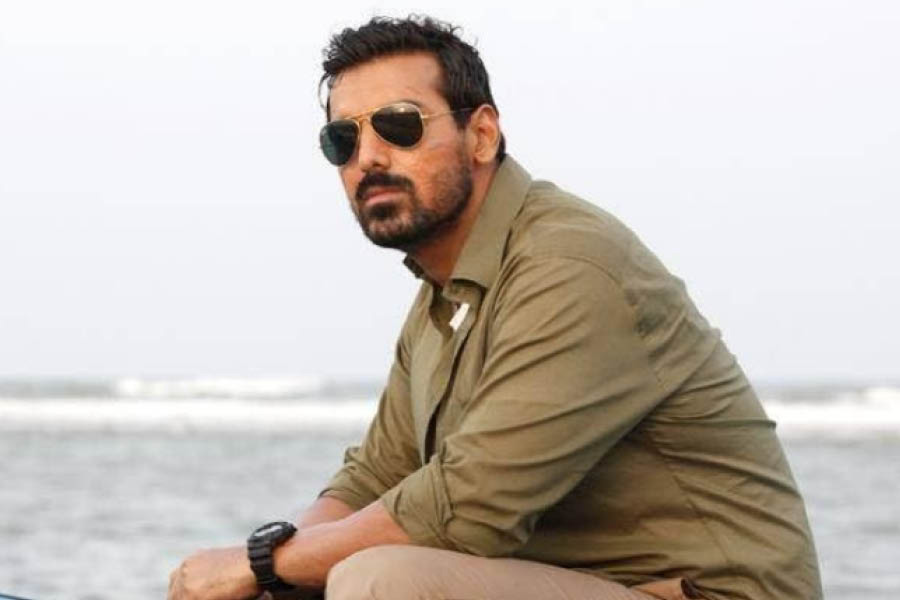|
|
Housewife Ritu Gupta at Modipuram near Meerut in Uttar Pradesh was tired of the poor picture quality she got on her cable TV connection. So Gupta began subscribing to a Dish TV direct-to-home (DTH) connection 18 months ago. Though Dish TV did not provide her with her favourite channel Star Plus, she was able to get crystal clear picture quality and a host of Hindi film channels by using Dish TV’s set-top box. Gupta is now looking forward to trying out the new movie-on-demand service Dish TV has launched.
This involves a subscriber sending an SMS to a given number. The request eventually reaches the central video server of the company, which then activates the film for the customer’s set-top box.
Ritu Gupta is among the nearly 6.5 lakh Dish TV subscribers who can now access the first ever interactive TV service launched by a DTH operator in India.
“For a price of Rs 40 a film, the subscriber will be able to access the movie through his set-top box for 24 hours. And the whole family can watch it at its convenience,” says Sunil Khanna, CEO, New Era Entertainment Network Ltd, the Zee group company that runs Dish TV. “It is like hiring a DVD,” he adds.
To be sure, DTH has been around for nearly two years. The state-owned Prasar Bharti’s year-old Doordarshan Direct Plus DTH service is free and has penetrated 4.6 million homes. Khanna claims that Dish TV will have a million subscribers by March 2006 and two million by March 2007.
But DTH is poised to take off in a much bigger way next year. The current Indian satellites (DTH guidelines say that only an Indian satellite can be used) had no extra transponder capacity and so new DTH companies couldn’t launch services. But the Indian Space Research Organisation is scheduled to launch Insat 4A on December 22 from French Guiana. Insat 4A has 12 KU band transponders and 12 C band transponders (KU band transponders support digital signals; one transponder can, roughly, carry 12 TV channels.) DTH wannabe Tata Sky, a joint venture between the Tata group and Rupert Murdoch’s Star group, has booked all the KU band transponders. Two more satellites in the Insat series, Insat 4B and 4C, are in the pipeline. Once they are launched, they will add another 24 KU band transponders for DTH operators.
That’s not all. At least three new business groups will be launching DTH services. The first to take off should be Tata Sky. Last week, the telecommunications ministry cleared the project after the information and broadcasting ministry cleared it earlier. Kalanithi Maran of Sun Network and Anil Ambani are also likely to launch DTH services.
What precisely is DTH? If you have a DTH connection, you’ll receive television signals directly from a satellite in the sky at your house with the help of a small (40 to 60 cm) KU band dish (satellite signals are received on S band, C band and KU band; DTH works on KU band as a smaller dish is required) and a digital set-top box attached to your TV set. And your cable operator is completely bypassed ? you don’t need him at all to get your TV channels.
What is more, you’ll be able to get niche TV channels that are not available through cable operators as well as premium interactive television services. Explains Vikram Kaushik, CEO of Tata Sky: “We will be able to offer DVD quality picture and CD quality sound. As the signal travels in digital form till the subscriber’s home, there is negligible data loss, resulting in better picture quality.”
Why are businessmen and consumers looking at DTH, considering that nearly 40,000 independent cable operators service 61 million cable TV homes across the country?
For one, the cable operators’ pipes are choked. They show between 60 and 100 channels through their analogue cable system (unlike digital signals, analogue signals aren’t compressed and so, take a lot of space) and cannot accommodate more channels. For another, cable operators have to pay a fee to television broadcasting companies like Star and Zee for television programmes on the basis of the number of subscribers they have ? and some of them under-declare their subscriber numbers.
DTH will change that, quite simply because DTH companies will be able to directly track their subscribers through their set-top boxes. Each customer’s box has a unique identity, the details of which are logged into a server.
The most exciting aspect of DTH is the range of new TV programmes the public will have access to. Zee’s Dish TV offers more than 130 channels, including an exclusive Pakistani films channel called Filmazia, Goal1 and Goal2 (football channels) and Boomerang, a commercial-free animation channel for children.
The Tata Sky CEO is right now chary of disclosing information on what programmes the company will offer, but Tata Sky will offer a premium service, apart from services for the masses, a Tata Sons director earlier told The Telegraph.
The kind of services the consumer can expect is reflected in the two new interactive services that Dish TV is launching this month. For instance, if you do not wish to watch the entire national news to get to the sports news at the fag end of the bulletin, you could simply click on sports news and access it instantly. “Today technology allows us to make this possible,” says Khanna.
 |
 |
| Vikram Kaushik, CEO, Tata Sky (above); Sunil Khanna, CEO, New Era Entertainment Network Ltd |
Sports buffs will have a multitude of options ? scoreboards, the highlights of a game and a player’s track record, all at the click of a button. It will also soon be possible to watch a game from different camera angles. Says Khanna: “Any sports event is covered from different camera angles and all of these are beamed up to the satellite. We will make all the beams on different channels. At the click of the remote, you can switch the camera angle while watching, say, a cricket match.”
Dish TV will also give subscribers a gaming play station that can be activated on set-top boxes. This will offer a range of strategy and board games and puzzles. However, for those willing to fork out Rs 16,000, the company will offer a set-top box with a recorder.
Called a Personal Video Recorder (PVR), the digital box has up to 80 gigabytes of space. A PVR will allow you to watch one channel while recording another.
Khanna claims he got advance bookings for over 50 PVRs during a recent trade fair in Delhi. Clearly, DTH operators are ready to usher in pay per view and personalised content to discerning customers willing to pay the price. Khanna is upbeat about the premium services DTH plans on unveiling. He says worldwide almost 20 per cent of DTH subscribers opt for value-added services. He believes that film premiers on DTH will fetch substantial revenues. “We will also create films specially for our DTH viewers,” he adds.
How much will DTH services cost? To get Doordarshan’s DTH, you need to invest in a dish and set-top box (approximate cost: Rs 3,000) and you can receive all the Doordarshan channels, several private news channels and at least 12 radio channels. Currently, Dish TV is offering the box and the dish for Rs 3,990 and a free one-year subscription to ramp up subscriber numbers. It’s not clear how much Tata Sky will charge, but a Tata Sons director had earlier said that the subscription fee could be about Rs 250 (roughly what cable operators charge in the metropolitan cities) for plain vanilla services and Rs 500 for premium services.
Needless to say, DTH companies have aggressive growth plans. Though Prasar Bharati’s DTH service is not a commercial venture, its CEO K.S. Sarma is keen to expand the DTH bouquet to 50 channels in the next six months. Tata Sky is not talking about subscriber numbers as yet. “Our DTH service will be for the masses where consumers can select and pay for the package of channels they want to watch,” says Kaushik.
With all this going for it, DTH companies feel that DTH will penetrate at least 30 per cent of India’s cable TV homes, that is, nearly 18 million households, in five years. “Growth rates in DTH will be exponential because the base is so low,” observes Ernst & Young director Farokh Balsara.
Still, DTH companies could face competition from Internet Protocol TV (IPTV), delivered via broadband services. IPTV is a three-in-one service ? television channels, telephone line and an Internet connection ? that’s popular in Japan and Korea and is being introduced in the US and Europe. In India, Bharti Tele-Ventures and Reliance Entertainment have been running IPTV trials in the country. But DTH companies dismiss the IPTV threat. Says Tata Sky’s Kaushik: “India is a large enough market for multiple technologies to survive. Having said that, DTH is an established digital pay television technology in the world. IPTV is still in its infancy.”
Whatever the case, there’s little doubt that competition will ignite the provision of better service quality in the industry.
As Dish TV customer Gupta points out: “For the last four months my son has been trying to get HBO activated on our set-top box, but to no avail. Neither the call centre nor the dealer has managed to service us,” she complains. And though she hasn’t heard either of IPTV or the Tata Sky DTH platform yet, Gupta is willing to switch to any company that gives her good service and a value-for-money product.
DTH’s pros...
• DTH eliminates the cable operator. The TV signals reach a customer’s home directly through a satellite and are received through a dish.
• DTH’s digital signals offer a high-quality viewing experience. All the channels are uniform in their clarity and offer DVD quality picture and CD quality sound.
• DTH companies offer exclusive channels that may not be available through a cable operator. Besides, you can chose from a menu of TV channels and pick only what you want.
• The system offers interactive services such as movie-on-demand , gaming etc. You can also record and store programmes if you have a premium set-top box.
...and cons
• Not practical for apartment blocks. To receive the signal, the DTH dish must be in the direct line of sight of the satellite through the window or balcony where it is placed. Trees and buildings obstruct satellite signals.
• People with many TV sets will need a separate set-top box for every TV set to get DTH signals. Experts suggest that a bigger KU band dish should be used if a house wants DTH for many TV sets.
• Set-top boxes of different DTH operators are not inter-operable. If you are unhappy with your service provider and want to switch to another company, you will have to invest in a new set-top box.
• Content on DTH is a contentious issue. Dish TV is unable to offer Star’s channels as the latter refuses to give its channels to it. Star has gone to court against a Telecom Regulatory Authority of India order that broadcasters have to offer television content to all DTH companies.












